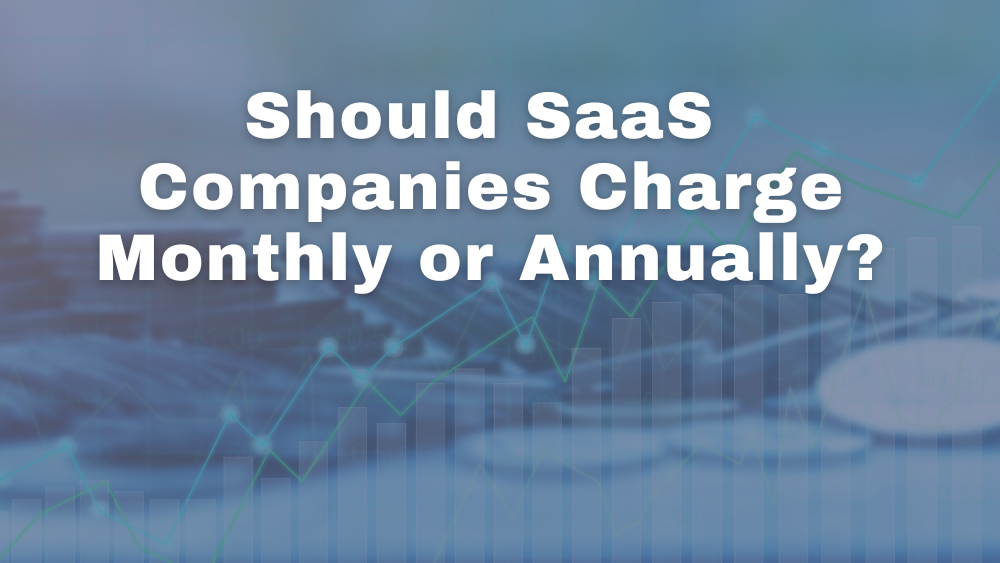Should SaaS Companies Charge Annually or Monthly?

Should SaaS Companies Charge Annually or Monthly?
When it comes to setting up a SaaS subscription model, many business owners have the same question. Should SaaS companies charge annually or monthly? After all, pricing can have a direct impact on revenue. Anthony Nitsos, the founder and CEO of SaaS Gurus, is here today to help SaaS business owners answer the question of how to set up their SaaS subscription model effectively.

Should SaaS Companies Charge Annually or Monthly?
I have clients on both sides of the fence. The answer lies in whether your SaaS company is B2B or B2C focused. For my B2B clients, annual in advance is the gold standard and the reason for that is capital efficiency. B2C clients are more focused on the transactions that can boost their gross margin metric. SaaS companies want their gross margin to be at 80%, and B2C companies do that by focusing on individual transactions. When determining your SaaS Subscription model, the first step is to determine if your company is B2B or B2C focused.

Consider Capital Efficiency When Setting Up SaaS Pricing Model
Capital efficiency is a metric that isn’t talked about a lot but should be. It’s a metric focused on the ratio of capital spent to revenue generated. For SaaS companies, it’s specifically focused on the ARR return on each investment dollar spent. How many millions of dollars of investment does it take you to get a million dollars of ARR? Or how many dollars of investment per dollar of ARR?
If I’ve had 10 million invested into my company and I just reached a million in ARR, my capital efficiency is 10 to one. That’s a terrible ratio, by the way. It should be lower than that. The median for all SaaS companies is around 1.5 or 2.5 to one. Capital efficiency should be in the low single digits. I come from a company where the capital efficiency was 0.125. Out of the 50 million invested into the company, 37 and a half of it was still in the bank when they reached a hundred million in ARR. The company was able to achieve that because of annual paid in advance.
When you pull cash in from annual advances, it allows you to operate your company without using your investment capital. Then, when it’s easy to get investment capital, you can grab it for cheap. Then you have what’s called dry powder. You’ve got a keg of fuel if you need it.
When Monthly Subscriptions Affect Gross Margins
In the B2C world, you’re talking about a lot of transactions. Many of its driven by merchant services and the fees you’re getting every time. Not only that, but you also have to set up the systems to handle monthly transactions. Once they’re set up, they should scale pretty well, so I don’t think that’s the big issue.
The issue is when business owners give a percentage of their gross margin away due to a monthly SaaS subscription model. The gross margin metric is a huge metric for SaaS companies. Companies want their gross margin to be 80% or higher because that’s where you’re going to get your max valuations.
A Real-World Example
We had a client that was accustomed to an annual SaaS pricing model. They were a B2B client that was selling into institutions and organizations in industry and academia. But when they started going to the enterprise level, they expected that their now 150 and $200,000 annual subscriptions were going to get paid in advance.
The problem was that at the enterprise level, clients wanted monthly invoicing. The financial plan was built assuming there would be a certain number of enterprise deals paid in advance annually. Suddenly we had to rework the model because of the market response. Not cashing in on the annual advance meant that they would run through their cash flow earlier than anticipated.
Paid in advance annually is huge. It gives you cash today to run your company, so you don’t have to use investment money. That’s where having the machine right at your fingertips to dial in on those scenarios can help you avoid a train wreck you don’t see coming.
Keep Reading: How to Scale a SaaS Business for Exponential Growth
Anthony Nitsos, Founder and Fractional CFO
Anthony Nitsos elevates your financial strategy to meet challenges and drive your company value. Working with pre-seed to Series B stage SaaS startups, he ensures that founders have reliable metrics and a solid understanding of the true economics of their business to maximize valuation. He optimizes financial operations, sales operations, human resources operations, and risk management systems. He’s worked with various startups, including two unicorn exits.

